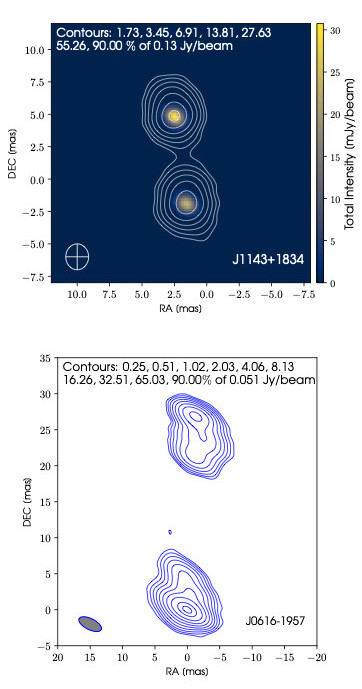
SMILE: Searching for MIlli-LEnses
by Carolina Casadio (Institute of Astrophysics, FORTH, Greece)

(colours in J1143+1834) EVN images of two
milli-lens candidates.
One of the most compelling mysteries in both cosmology and particle physics is the nature of Dark Matter. Its elusive detection coupled with unsolved discrepancies between some standard cosmo-logical (Lambda-CDM) model predictions and observations have paved the way to alternative DM models.
A critical prediction of the CDM paradigm is the number of DM halos at sub-galactic scales, i.e. masses below ~1010 solar masses. Constraining this number would help discarding many currently viable Dark Matter models. We investigate this problem using strong gravitational lensing of active galaxies on the key but poorly-explored milli-arcsecond scales, i.e. milli-lenses. Gravitational lensed images with angular separation on milliarcsecond scales probe gravitational lens systems where the lens is a compact object with mass in the range 106 – 109 solar masses. Compact objects in this mass range could be i) sub-galactic Dark Matter halos (in the surroundings of galactic Dark Matter halos or in the field), ii) primordial black holes, also considered an alternative candidate to Dark Matter particles, (iii) supermassive Black Holes hosted by galaxies.
The most direct way to explore these small angular scales is through the high-resolution of radio Very Long Baseline Interferometry (VLBI). We performed a pilot search for milli-lenses with angular separation < 150 mas, using the publicly available multi-frequency VLBI data in the Astrogeo VLBI FITS image database, containing data of 13,828 sources. For our search, we visually inspected all images creating a web-page based on the idea of citizen-science projects. 5 PhD scientists and 9 undergraduate Physics students from the University of Crete (Greece) were involved in the search, and asked to mark as "Lens" sources showing multiple compact components in at least one of the available observing bands, and as "No Lens" the rest of the sources. Each source in the database was inspected by one user and the corresponding choice was recorded. After many visual selection steps, we finally use the surface brightness preservation criterion to obtain the list of 40 best milli-lens candidates. Since gravitational lensing preserves the surface brightness of the background source, we expect the lensed images to have all the same intrinsic brightness.
The 40 best milli-lens candidates have been followed up with the European VLBI Network (EVN) observations at 5 and 22 GHz (Project ID: EC071; PI: C. Casadio), and the analysis of data is currently on-going. New EVN images of two (J1143+1834, and J0616-1957) of the best milli-lens candidates are shown in Figure 1. The two sources confirm their double structure, but while the two components in J1143+1834 are slightly resolved, in J0616-1957 we clearly distinguish two jet-like features that may indicate a different nature for this object. Further analysis will allow us to reject or confirm the milli-lens candidates. Any sources rejected as milli-lens candidates can still be investigated as candidates for a binary supermassive black hole or a compact symmetric object.
Published in Casadio et al. 2021. MNRASl (doi: 10.1093/mnrasl/slab082).